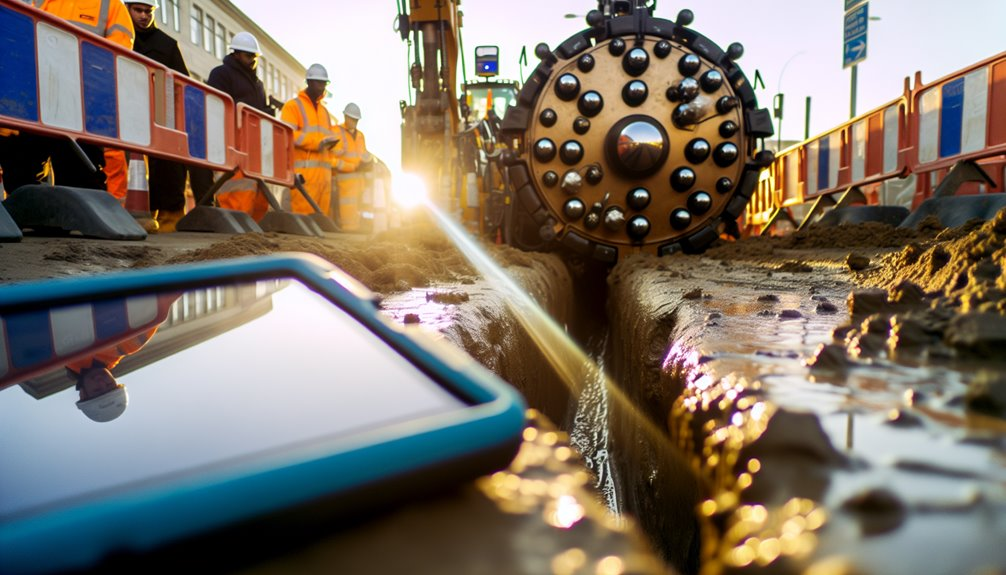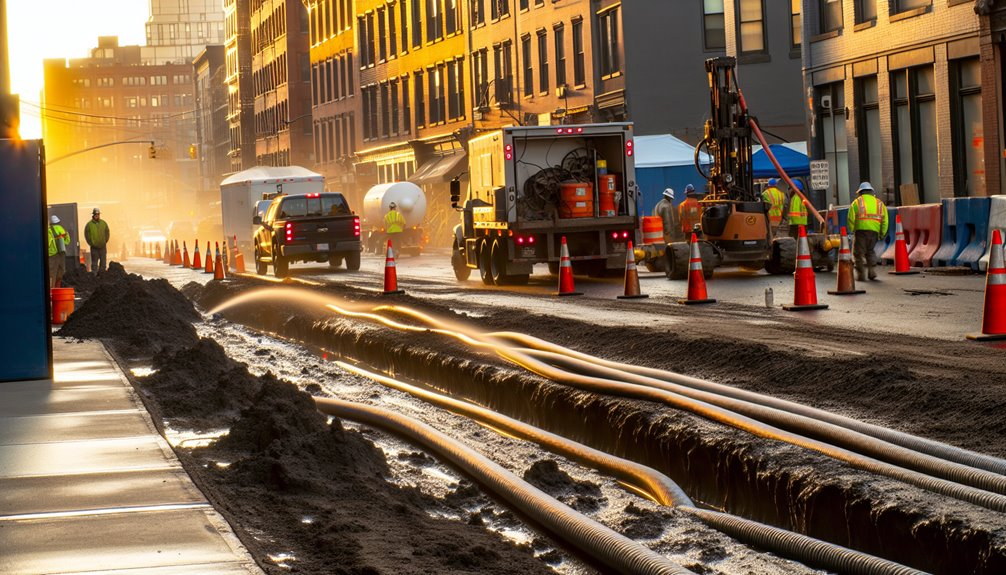You face buried utilities, traffic, groundwater, and tight tolerances that make open‑cut risky. Microtunneling uses a remotely controlled MTBM with laser/gyro guidance and EPB or slurry face control to hold line and grade within millimeters, limit settlement, and keep services online. Mobilization is higher, but restoration, safety, and schedule often improve. If you’re weighing trench shields against launch shafts, the data on precision, risk, and cost curves may surprise you.
How Microtunneling Works: Equipment, Setup, and Control
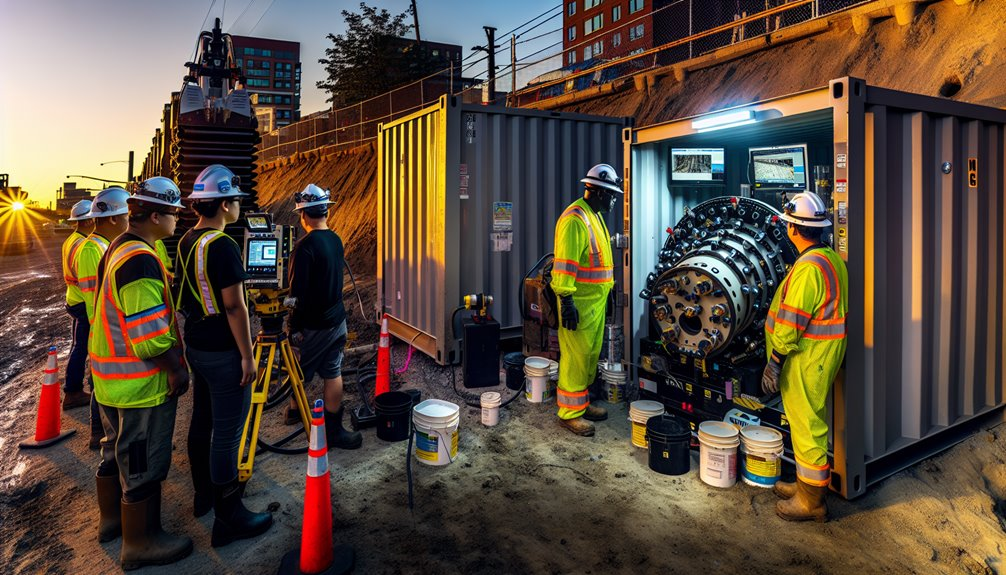
Although site conditions drive configuration, microtunneling pairs a remotely controlled microtunnel boring machine (MTBM) with a jacking system that advances welded pipe from a launch shaft to a reception shaft along a surveyed line and grade.
You stage slurry separation, power packs, guidance, and control cabins topside; below, the MTBM cuts, conditions face pressure, and conveys spoils via closed-loop slurry. You track line/grade with laser or gyro guidance and adjust steering cylinders to maintain tolerances within millimeters.
You’ll calibrate thrust, torque, slurry density, and flow to match geotechnical parameters. Remote monitoring streams sensor data—MTBM attitude, annular pressure, jacking loads—for real-time decisions and QA records.
Operator training standardizes responses to overcut, tool wear, or clogging, reducing downtime. Preconstruction mockups validate setup, shaft alignment, and contingency protocols.
Applications Where Microtunneling Excels
When access is limited and tolerances are tight, microtunneling delivers trenchless installs with millimeter-grade control for gravity sewers, pressure mains, and utility crossings under highways, rail, airports, and waterways. You deploy it where settlement windows are zero and hydraulic grade lines must hold: dense urban corridors, industrial crossings with 24/7 operations, and river diversions demanding low-risk subfluvial drives. With pressurized face control and laser guidance, you maintain line-and-grade through mixed face, high groundwater, and variable strata while minimizing disruption to stakeholders.
- Tight-radius alignments beneath critical assets requiring continuous service uptime
- Long drives with compound curves where annular pressure and jacking loads are monitored
- Low-cover installations needing real-time EPB/slurry balance to manage buoyancy and heave
You’ll meet environmental permits, protect existing utilities, and deliver predictable as-built geometry.
Comparing Costs, Schedules, and Risks to Open-Cut
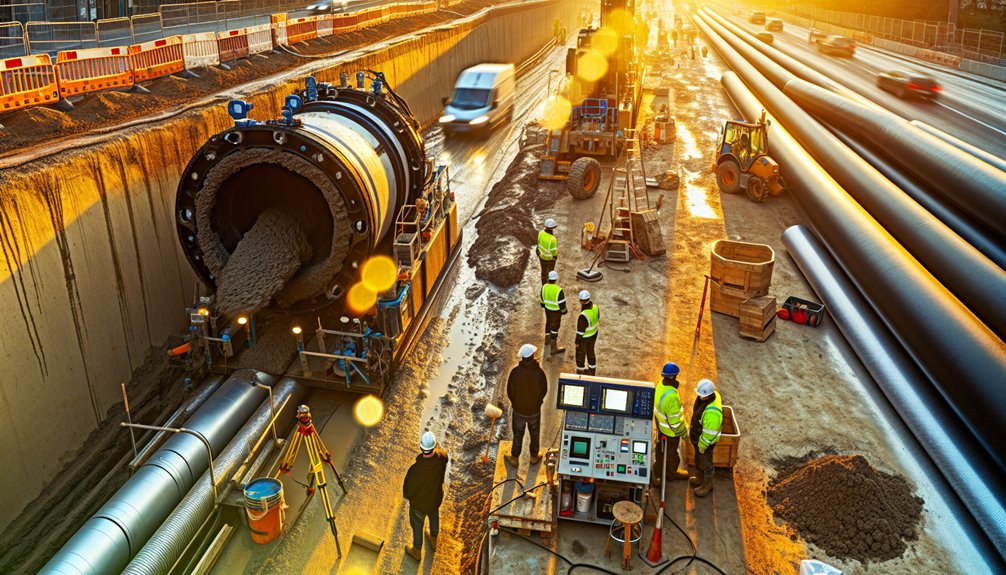
Beyond first cost, you compare delivery models on whole-life cost, schedule certainty, and quantified risk.
Microtunneling typically carries higher mobilization but lower Life cycle costs through reduced surface restoration, fewer utility conflicts, and longer service life from factory-jointed pipe.
You also cut indirects: traffic control, dewatering, and environmental compliance.
Schedule risk compresses because you parallelize shaft construction and drive sequencing, while avoiding permit delays tied to lane closures and trench spoils.
Quantitatively, you reduce Community disruption—fewer detours, noise windows, and business-access impacts—measured via user-delay costs and stakeholder complaints per block.
Risk registers shift: trench collapse, strikes, and weather exposure diminish; equipment downtime and jacking force exceedance become primary.
With progressive design-build or CM/GC, you lock contingencies early and stabilize cash flow.
Ground Conditions, Tolerances, and Design Considerations
Because microtunneling performance hinges on the ground you drive through, you start with a defensible subsurface model and design to its tolerances. You quantify lithology, UCS, abrasivity, fines content, and permeability, then set face pressure, slurry density, and cutterhead selection accordingly. You map faulted zones, boulders, and potential soil liquefaction lenses, validating with CPT, pressuremeter, and piezometer data.
Tolerances derive from alignment, jacking load, and settlement criteria; you size pipe stiffness, overcut, and lubrication to maintain them. Groundwater management governs face stability and inflow control.
- Specify design face pressures using limit‑equilibrium and slurry column calculations.
- Calibrate jacking loads with friction models and real‑time thrust data.
- Control settlement via annulus lubrication rate, overcut, and advance/steering corrections.
Selecting the Right Delivery Method and Project Team
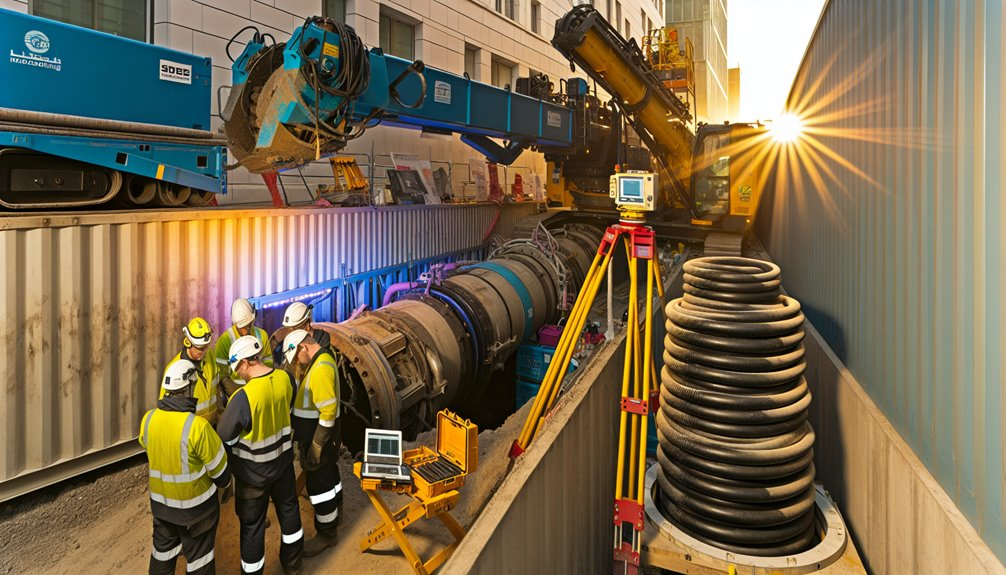
With ground behavior and tolerances quantified, you align delivery strategy to risk allocation, decision speed, and supply-chain readiness. Select a delivery model—Design-Bid-Build, CM/GC, or Design-Build—by mapping geotechnical uncertainty to price certainty and change-order exposure. Use contracting strategies that incentivize MTBM availability, face-pressure control, and slurry management KPIs. Define decision gates: cutterhead selection, jacking force limits, and overcut targets tied to measurable performance.
Build a team with trenchless design leaders, HDD/MTBM hybrid thinkers, and a contractor with proven AVN or EPB fleets and telemetry analytics. Require OEM service commitments, spare-part lead-time buffers, and 24/7 response. Formalize stakeholder coordination with utility owners, traffic agencies, and permitting authorities via weekly dashboards, risk registers, and deviation logs. Validate readiness with pilot shafts and factory acceptance tests.
Conclusion
As the owner of Boring Bros., I’ve seen firsthand how MTBM with laser/gyro guidance, EPB/slurry face control, and careful jacking can hit ±10 mm line and grade in mixed ground while keeping settlement and surface impacts to a minimum. We recommend microtunneling when utilities, traffic, or waterways make open cut impractical, or when groundwater control and tight tolerances raise the stakes — because the reduced restoration, fewer service outages, and improved safety can often offset the higher mobilization costs. Get geotech baselines, tolerances, and shaft logistics locked in early, and bring an experienced, integrated design‑build team on board to de‑risk delivery. If you want to talk through a project or learn more about how we might help, please visit boringbro.com or give us a call at (954) 639-6167 — we’d love to hear from you.

